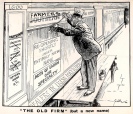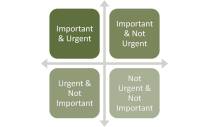Just over three years a go, ‘Clinical Medicine’ (the journal of the Royal College of Physicians) launched a series of articles in which the history of the National Health Service (NHS) was reviewed, and several eminent commentators surveyed the health- care landscape that was expected to emerge once the dust from the 2010 general election had cleared.
go, ‘Clinical Medicine’ (the journal of the Royal College of Physicians) launched a series of articles in which the history of the National Health Service (NHS) was reviewed, and several eminent commentators surveyed the health- care landscape that was expected to emerge once the dust from the 2010 general election had cleared.
Thus, there were articles by the likes of Mike Farrar, chief executive of the NHS Confederation, Michael Dixon, chairman of the NHS Alliance, and Mark Britnell, from the management consultancy KPMG, as well as contributions covering subjects as diverse as system reform to improve NHS efficiency (Jennifer Dixon), the risks and challenges for a new public health system (John Middleton), the future of patient and public involvement in the NHS (Jo Ellins), the role of the National Institute of Health and Care Excellence (NICE) in assessing new technologies and value for money (Andrew Stevens et al) and the then impending commissioning reforms (Elizabeth Wade).
We are now well into the current round of reforms and, with less than two years until the next general election, it is a good time to review the events of the past three years, and speculate on future possibilities and developments.
Political context
The first thing to say is that the initial White Paper presented by the then Secretary of State, Andrew Lansley, during the summer of 2010 took most commentators by surprise. In the lead-in to the election, it had been observed that there was a basic convergence in policy and even organisational style on both sides of the political divide: the concept of the purchaser/provider split was an integral part of both Labour and Conservative policy; the independence of acute provider trusts was taken as read; and the centrality of primary care in coordinating their local health economies had been generally accepted.
Thus, it was largely assumed that, if a Conservative Government did win the election, its policies would be aimed at tweaking and refining the pre-existing direction of travel, rather than overhauling it radically and, indeed, the tenor of the manifesto of the party gave no hint of major structural changes. Such tweaking could even be interpreted as being helpful in making the NHS increasingly able to resist political change, as the policies of the main parties began to resemble each other, even if only in principle.
In the event, when the Liberal Democrat–Conservative coalition was formed and Andrew Lansley was confirmed as Secretary of State for Health, the coalition White Paper incorporated significant restructuring, and a philosophical ‘decentralisation’ that was seen as almost libertarian in its extent. The key suggestions of the document are detailed in Table 1 at the end of this piece, and now look faintly ironic, even after only three years.
A difficult gestation
As with all White Papers, the document was intended to form the basis of a Parliamentary Bill, but during its gestation, there was perhaps more debate among the various vested interest groups than was the norm; nearly all of these groups, lay as well as professional, opposed parts of it, with the most strident criticisms concerning the transfer of so much of the NHS resource to the control of general practitioners (GPs), the apparent abrogation of their responsibilities by politicians and the intention to allow the NHS to be driven so locally, with the variabilities that that implied. The fact that all the debate was being carried out under the cloud of the ‘Nicholson Challenge’ (a call for the NHS to save up to £20 billion over five years that had been issued in 2009 by Sir David Nicholson, the chief executive of the NHS as a response to the increasing austerity being rolled out across the country) added to the tensions and mutual paranoia being felt both politically and in the service itself.
In hindsight, the outstanding lesson from the launch of the White Paper was less about its content, most of which was more or less in line with the aforementioned direction of travel, than the manner in which it was introduced. The Secretary of State seemed to show a degree of political naivety in his approach to the powerful lobbies with which he had to deal and he introduced a whole raft of structural changes that were both unexpected and unwelcome, as well as perhaps unnecessary to enact the proposed reforms.
Such was the level of ‘noise’ concerning the White Paper that an official ‘pause’ was introduced, during which a Future Forum was convened, led by Professor Steve Field, the outgoing chairman of the Royal College of General Practitioners. Its official brief was to carry out a ‘listening exercise’ to consult widely and to modify the White Paper in line with its findings; to this end, the Forum comprised primary and secondary care members, nurses and Allied Health Profession (AHP) members as well as doctors, managers and representatives from other groups, including various patients associations and the voluntary sector.
The unofficial remit of the Forum was to ensure that the White Paper could be turned into a viable bill, although there were also suggestions that mechanisms were needed to counter the centrifugal force of Lansley’s ideas with some centripetal pressures to maintain parity across the service and behaviours in line with central Government policy.
The Forum met for some months (and, indeed, at the time of writing, has yet to be disbanded) and, although its activities did smooth the edges of the original proposals, some might say it changed their original intent. Enough organisational restructuring was introduced following its interventions, for instance, to obviate completely the promise concerning the ‘radical de-layering and simplification of the number of NHS bodies’. Its findings were incorporated into a revised bill, which was followed by more political wrangling in Parliament before the bill was finally turned into the 2012 Health and Social Care Act, which was fully enacted on 1 April 2013.
The 2013 Health and Social Care Act
Its final intentions and structures include the following, although it is too early to draw any conclusions about their effectiveness.
The major structural changes mainly concern the commissioning or procurement side of the NHS. The primary care trusts (PCTs) that were responsible for commissioning the vast proportion of all care for their local populations have been dissolved and many of their functions devolved into the new clinical commissioning groups (CCGs), which are each headed by a chair (usually a GP) and an accountable officer (AO); some AOs are clinical, whereas others are managerial in their backgrounds.
CCGs hold most of the budget for traditional hospital services and have the responsibility for planning and procuring these services, as well as holding them to account. In this task, they are assisted by the commissioning support units (CSUs), which are able to provide a variety of support tools, including payroll and human resources (HR), information and communications.
The CCGs have two strands of accountability within the system. The services provided within primary care (mainly general practice) are governed by the area teams, each one overseeing several CCGs. The strategic oversight of this, as well as the accountability for hospital services commissioned directly by the CCGs, sits with one of four regional bodies linked to NHS England. Clearly, each is holding responsibility for a large population and needs to develop the notion of locally developed services that are in tune with national policy while also knitting together the various funding and delivery streams that encompass primary care and hospital services to create a seamless and effective service map.
The public health function (traditionally involved in the prevention and health improvement agenda, health protection (including immunisation and screening) and generic service planning) has been split in two, with the mainstream operational services being moved to the control of the local authorities and the more strategic functions that cover larger populations, being housed in a new entity called ‘Public Health England’.
The whole system is intended to sit at some distance from its political masters, to try and insulate them from the public and media pressures that often divert policy from its intended direction. This approach was first tried during the early 1990s, under a previous Conservative government, which created the ‘NHS Executive’, housed in Leeds, in a finally futile attempt to create a similar gap between policy and service delivery.
The basic aims of all the NHS reforms of the past 30 years have been to try to bring into line behaviours and expenditure in the acute sector so that they fit with national policies and budgets. In the current round of changes, the main overt objective for this sector is simple: to ensure that all acute trusts reach the standards necessary to become foundation trusts, or if they cannot, to agree some form of strategic alliance with another organisation, so that together they might reach viability in terms of costs and quality.
However, the current changes, both planned (through the new Act) and unplanned (through crises, such as that in the mid-Staffordshire Foundation Trust) have highlighted a new, and much more significant ‘elephant in the room’, and that is the overall future of the district general hospitals (DGHs). There are several reasons why their future is now in considerable doubt.
Firstly, there is an inexorable move towards increasing specialisation, which average DGHs cannot supply; their budgets and turnover are too small, and their ability to recruit ‘premier league’ super-specialists is limited. As a result, the more ‘high-risk’ illnesses (risk being defined by cost, technical difficulty, infrastructure support, staff availability and even litigation risk) are being referred onto the tertiary ‘super-hospitals’, thus depriving the DGHs of work, income and work-related satisfaction for their high-level staff.
Secondly, there is an equally inexorable move of lower-risk illnesses out of hospitals and into the community, where their treatment might be carried out in less formal surroundings that are generally preferred by patients, by staff who can still deliver excellent care, but perhaps at a lower cost. With the shrinkage of this market too, the core business of the DGHs will become significantly smaller and will threaten their viability unless they change their form or their function dramatically.
Thirdly, there are the issues of scale; in the constant tussle between ‘small is beautiful’ and ‘bigger is better’, the size and complexity of the NHS probably mitigates against the former. Interestingly, there is a clear dissonance between the move towards super-hospitals, and the value placed on local treatment ‘closer to home’, that probably reflects the increasing polarisation of healthcare to these two extremes, which once again puts the future of the DGH in doubt. This tension is not new; as Aneurin Bevan said in April 1946, ‘I would rather be kept alive in the efficient if cold altruism of a large hospital than expire in a gush of warm sympathy in a small one.’ The difference is that the intensive interventions feasible today cannot easily be delivered in a small setting, reinforcing Bevan’s aphorism for the 21st century.
What next?
So what might we expect from the new system?
At a superficial glance, the new organisational structure might appear to be well placed to deliver what its designers wanted. It has attempted to separate the service from its political masters; it has declared a move to ‘localism’ and it will pass control of over two-thirds of the total NHS budgets to the CCGs.
However, there are significant structural issues that look likely to trip the system up. The first concerns the distinctions in funding of primary and secondary care.
Because the two streams are managed separately (hospital funding though the CCGs themselves, primary care through the area teams), there is no certainty that moving services from the acute sector to primary care will free up the resources to complete the transfer. However corporately minded GPs might be, they are unlikely to create extra work for themselves and their teams without the resources to manage this, and that process is entirely separate. As in so many previous rounds of NHS reform, the incentives in the system have not been properly aligned.
In the same way that the new system does not acknowledge the factors that motivate and drive GPs, the continuing emphasis on payment by results (PbR), which is a recipe for increasing activity and not improving results at all, is not helpful. In addition, the movement of the mainstream public health function into local authorities, although it might be appealing at a conceptual level (the drivers that influence the health of the population are largely outside the biomedical universe), the emerging reality seems to comprise mixed interest among local authorities, with some apparently not considering any of the broader determinants of health beyond repairing potholes and running sexually transmitted disease (STD) clinics.
So there are structural problems, but there are even larger and more significant issues in the processes that are now supposed to govern the NHS.
Lansley was probably unduly optimistic in his aspirations to have the NHS driven quite as locally as he intended, but in the intervening months and years that the Bill has evolved and become law, it has created a polarised dynamic between the CCGs at the local end and NHS England at the centre, with the power apparently settling increasingly at the central end. GPs and their PCT colleagues who took up the notion of CCGs are seeing their expectations and aspirations once again diluted and soured, with the result, even at this early stage, that there is already poor morale and reducing engagement.
Processes should not subsume outcomes
Clinical professionals in general, and GPs in particular, are in positions where they can make or break their local heath economy without ever doing anything wrong. Their motivation and enthusiasm are the only way that referrals and admissions might be reduced or prescribing improved and, if their zeal is missing (or worse still, lost), then the auguries for success are poor. Add to that the ‘Nicholson Challenge’ being pressed upon them and one can see the likelihood of short-term ‘fatigue’ in the new system and long-term disaster as new doctors consider their reasons for going into general practice in the first place, and begin to vote with their feet.
One final bit of soothsaying; if the new system was designed to preserve corporate memory while allowing new ideas and ways of thinking to emerge, then even that probably has not worked. As the CCGs and CSUs bed down, not only are they populated largely by staff who had worked in PCTs previously, but their growing ways of working, their modi operandi, also begin to look increasingly controlling, unimaginative and bogged down in ‘due process’. Tendering for service change, allowing experimental models of care, anything that rocks the boat of ‘doing things right’ is being frowned upon, even if it is at the cost of ‘doing the right thing’.
The road to Hell, they say, is paved with good intentions and it is easy to see how an Act designed by a committee that tries to please everyone is almost bound to fail.
In fact, the issues are remediable: if the accountability of the CCGs to NHS England was simplified into one stream based on outcomes rather than on processes, then the incentives for those in the CCGs would be more positive. The oft-cited ‘conflict of interest’ for GPs would be less relevant if they became responsible for delivering all health-care for their population, in any (appropriate) way they chose, ‘sub-contracting’ to others what they didn’t do themselves (and hence maintaining vicarious responsibility).
If the rules governing changes in the acute sector were simplified, and allowed more flexibility of function as well as structure, then some innovative and dynamic solutions to these ‘wicked issues’ would emerge. In addition, if those working in the NHS, especially at senior level, could see something positive about which they could be enthusiastic and in which they could invest their hearts and souls, then I suggest that this might be ‘another fine mess’ we could actually reverse.
Table 1. Summary of main suggestions in the White Paper Equity and excellence: liberating the NHS.
- Shared decision-making: ‘no decision about me without me’
- Choice of any provider, consultant-led team, GP practice and treatment
- Hospitals need to be open about mistakes
- Stronger voice for patients and the public
- Focus on outcomes and quality standards. Reduced mortality and morbidity, increased safety and improved patient experience and outcomes
- No targets without clinical justification
- A culture that puts patient safety above all else
- Money to follow patients across the NHS to promote quality, efficiency and choice
- Providers to be paid according to performance based on outcomes, not just activity
- Professionals and providers to have more autonomy and accountability
- Greater freedoms and less political micromanagement; ministerial powers over routine decisions to be limited
- Devolution of power and responsibility for commissioning to GPs and their practice teams working in consortia
- More connection between local NHS services, social care and health improvement
- An independent NHS Commissioning Board to lead on the following: achieving health outcomes, allocating and accounting for resources, quality improvement and patient involvement
- All NHS trusts to become, or be part of, a foundation trust
- Monitor to become an economic regulator, promoting effective and efficient provision, competition, regulating prices and safeguarding continuity of services
- Enhanced role for the Care Quality Commission as a quality inspectorate across health and social care
- Ring-fenced public health budgets, reflecting population health issues, with ‘premiums’ to reduce health inequalities
- £20 billion efficiency savings by 2014,to be used to improve quality and outcomes
- NHS management costs to be reduced by more than 45% over the next 4 years
- Radical de-layering and simplification of a number of NHS bodies
- Debate on health should no longer be about structures and processes, but about priorities and progress in health improvement for all
- Implementation to be bottom up
This piece is based on an article published in Clinical Medicine in August 2013: 2013, Vol 13, No 4: 374–7







